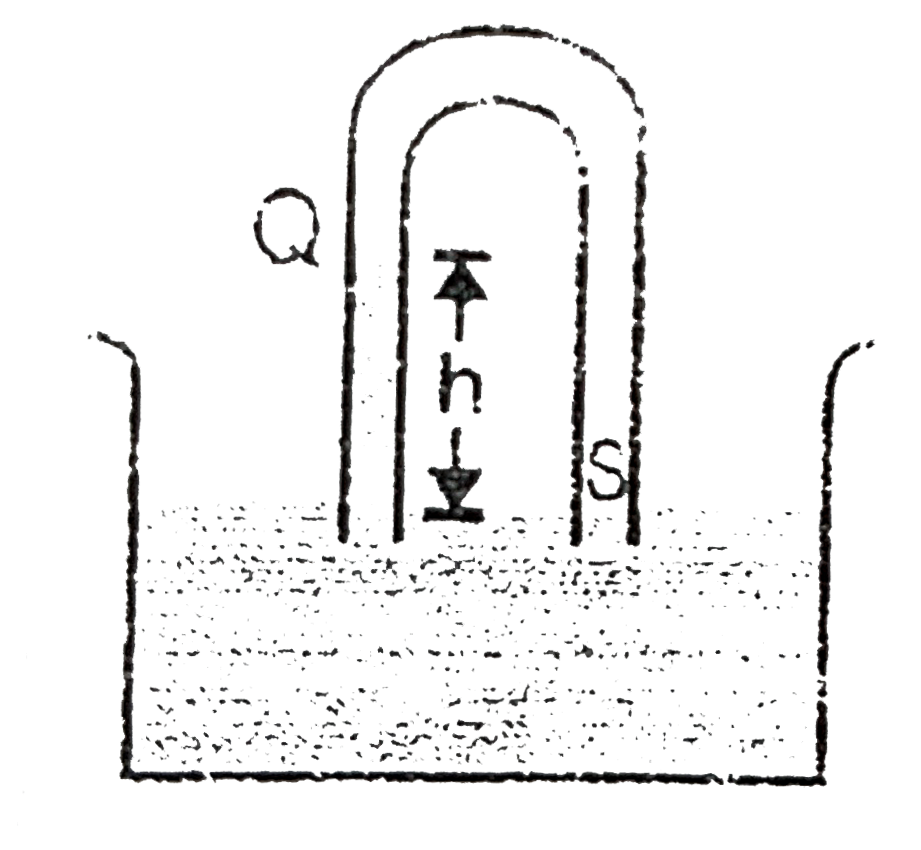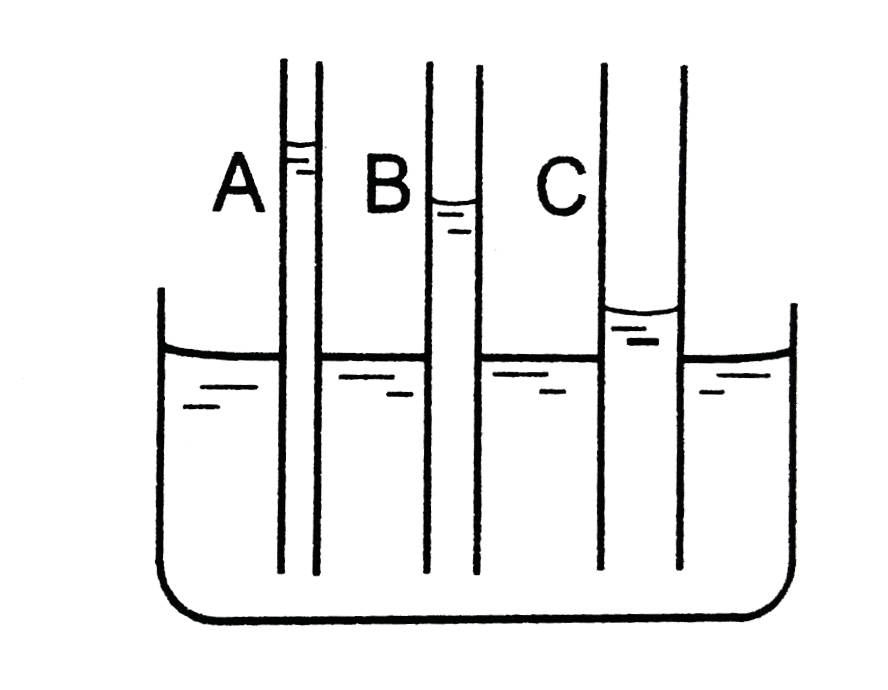A glass tube is inverted with open ends of the straight limbs, of diameters and below the surface of water in a beaker. The air pressure in the upper part is increased until the meniscus in one limb is level with the water outside. Find the height of water in the other limb in nearest integer. : (Density of water is and surface tension of water is . Take contact angle )

The correct Answer is:
Topper's Solved these Questions
- SURFACE TENSIONBOOK - RESONANCECHAPTER - SURFACE TENSIONEXERCISE - Exercise- 2 PART - III
3 Videos
- SURFACE TENSIONBOOK - RESONANCECHAPTER - SURFACE TENSIONEXERCISE - Exercise- 2 PART - IV
5 Videos
- SURFACE TENSIONBOOK - RESONANCECHAPTER - SURFACE TENSIONEXERCISE - Exercise- 2 PART - I
7 Videos
- STRING WAVESBOOK - RESONANCECHAPTER - STRING WAVESEXERCISE - Exercise
32 Videos
- UNITS, DIMENSION & MEASUREMENTBOOK - RESONANCECHAPTER - UNITS, DIMENSION & MEASUREMENTEXERCISE - Exercise
27 Videos
Similar Questions
Calculate the height to which the water will rise in a capillary tube of 1.5 mm diameter (surface tension of water =74×10−3Nm−1, angle of contact between water and glass =0∘).
View SolutionIf the lower end of a capillary tube of radius 2.5 mm is dipped 8 cm below the surface of water in a beaker, then calculate the pressure within a bubble blown at its end in water, in excess of atompheric pressure. [Surface tension of water 72×10−3 N/m]
View Solution
Knowledge Check
What will be the difference of pressure inside and outside a drop of water of radius 1.0 mm ? (The surface tension of water is 73 dyne/cm-)
A146N/m2B73N/m2C7.3N/m2D200N/m2
If the lower end of a capillary tube of radius 2.5 mm is dipped 8 cm below the surface of water in a beaker, then calculate the pressure within a bubble blown at its end in water, in excess of atompheric pressure. [Surface tension of water 72×10−3 N/m]
View SolutionThe lower end of a capillary tube of diameter 2.0 mm is dipped 8.00cm below the surface of water in a beaker. What is the pressure required in the tube in order to blow a hemispherical bubble at its end in water? The surface tension of water at temperature of the experiments is 7.30×10−2Nm−1. 1 atmospheric pressure =1.01×105Pa, density of water =1000kg/m3,g=9.80ms−2. also calculate the excess pressure.
View SolutionThe lower end of a capillary tube of diameter 2.0 mm is dipped 8.00cm below the surface of water in a beaker. What is the pressure required in the tube in order to blow a hemispherical bubble at its end in water? The surface tension of water at temperature of the experiments is 7.30×10−2Nm−1. 1 atmospheric pressure =1.01×105Pa, density of water =1000kg/m3,g=9.80ms−2. also calculate the excess pressure.
View SolutionThe capillaries shown in figure have inner radii 0.5 mm, 1.0 mm and 1.5 mm respectively. The liquid in the beaker is water. Find the heights of water level in the capillaries. The surface tension of water is 7.5×10−2Nm−1.

View SolutionThe lower end of a capillary tube of diameter 2.00 mm is dipped 8.00 cm below the surface of water in a beaker. What is the pressure required in the tube in order to blow a hemispherical bubble at its end in water? The surface tension of water at the temperature of the experiments is 7.30×10−2N/m. 1 atmospheric pressure =1.01×105Pa density of water =7000 kg/m3,g=9.80 ms−2. Also calculate the excess pressure.
View SolutionA glass capillary tube of inner diameter 0.28mm is lowered verically into water in a vessel. The pressure to be applied on the water in the capillary tube so that water level in the tube is same as that in the vessel is λ×105N/m2. Then find λ in nearest integer (surface tension of water =0.07N/m and atmospheric pressure =105N/m2) :
View SolutionA vertical vapillary with inside diameter 0.50mm is submergeed into water so that the length of its part emerging outside the water surface is equal to 25mm. Find the radius of curvature of the meniscus. Surface tension of water is 73×10−3N/m.
View Solution
